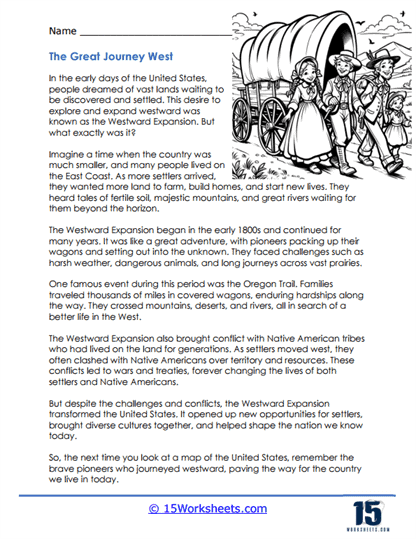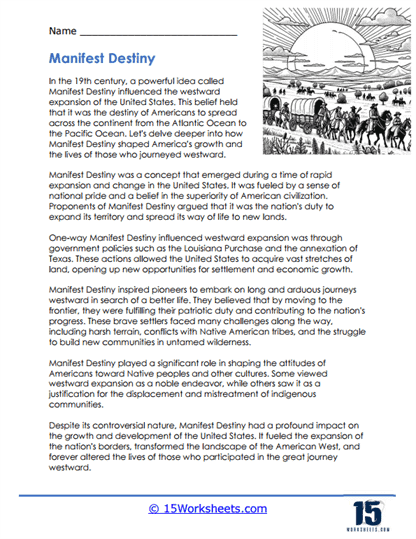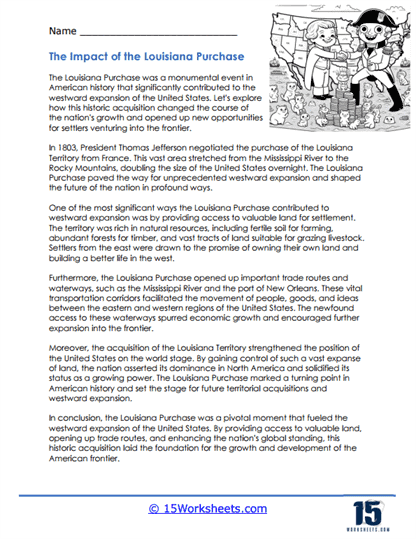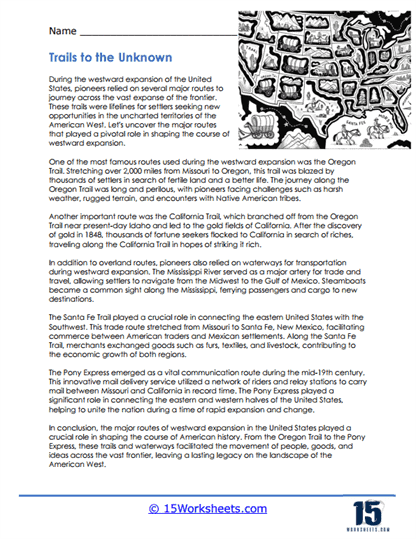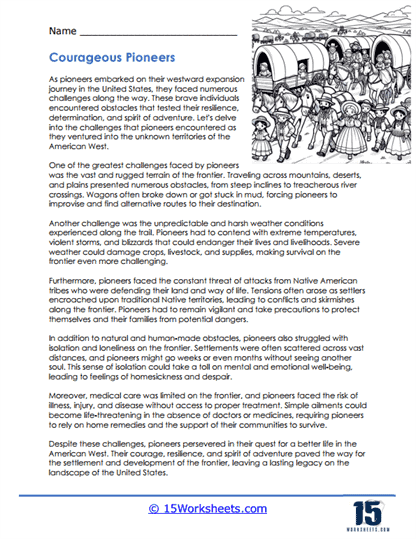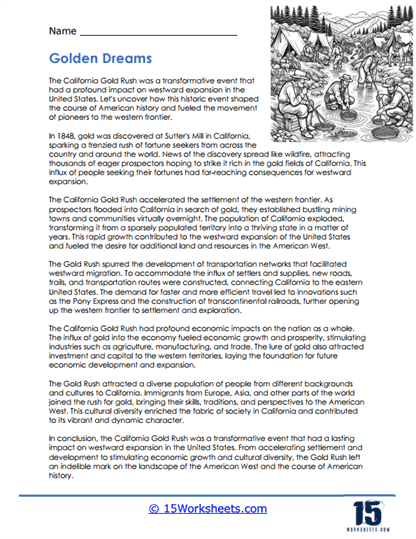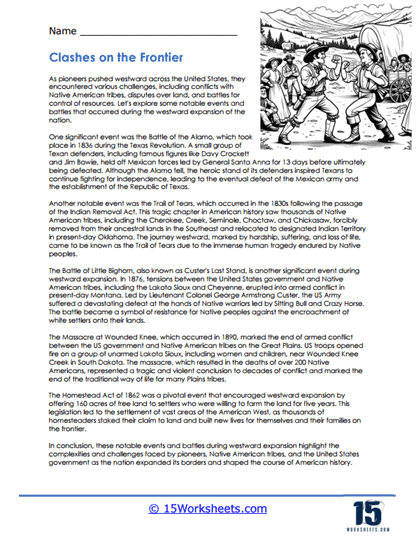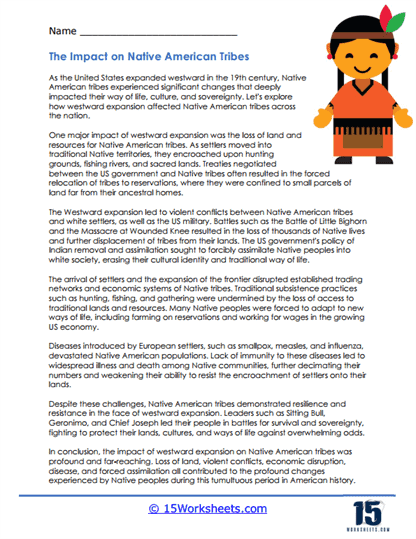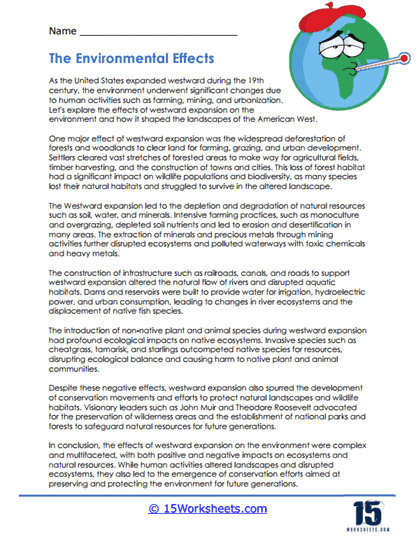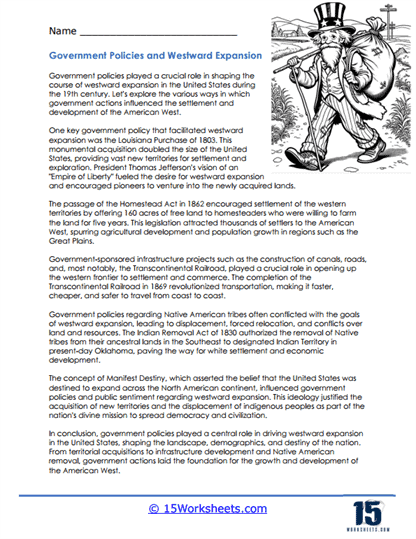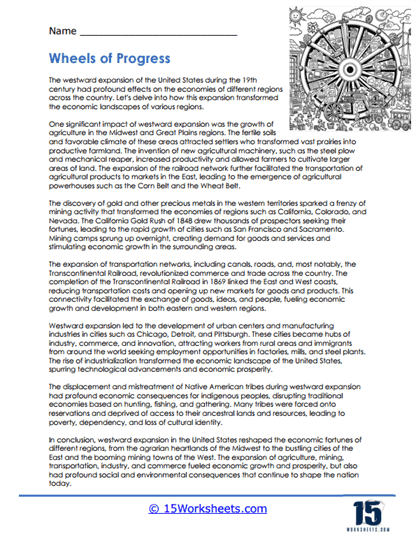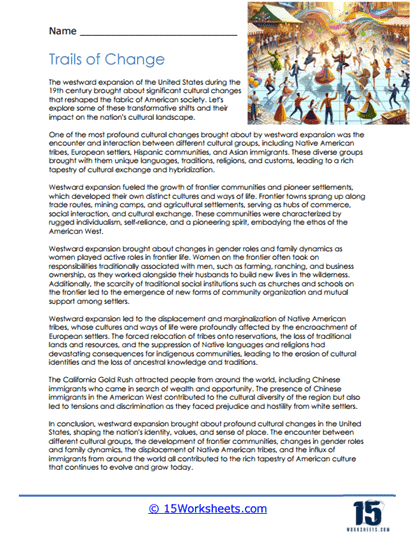Westward Expansion Worksheets
About These 15 Worksheets
Westward Expansion worksheets are educational tools designed to help students explore the period in United States history when the nation expanded across North America from the original 13 colonies to the Pacific Ocean. This era, which primarily took place throughout the 19th century, is significant due to its impact on the development of the United States in terms of geography, culture, politics, and interactions with indigenous peoples. By engaging with a variety of exercises found on these worksheets, students deepen their knowledge about this pivotal time and improve their overall historical understanding.
Through a blend of factual learning and skill development, these worksheets equip students with the knowledge and abilities to better understand their nation’s past and its implications for the present and future.
Types of Exercises
Reading Comprehension Questions – These exercises typically involve a passage detailing aspects of Westward Expansion, such as the Louisiana Purchase, the Oregon Trail, or the Gold Rush. After reading, students answer questions to test their understanding of the text. This practice helps students focus on key details and themes and develop their ability to analyze historical documents.
Map Skills Activities – Students are often provided with maps depicting the United States at different stages of expansion. Exercises might include identifying newly acquired territories, tracing the routes of early settlers and explorers, or labeling significant geographic features and trails. These tasks enhance students’ geographical knowledge and understanding of how the landscape influenced movement and settlement patterns.
Timeline Creation – Creating a timeline of major events during Westward Expansion helps students understand the sequence and context of historical events. This can include key dates like the signing of treaties, major battles with Native American tribes, or the admission of new states to the Union. Timelines help students visually organize and connect historical events.
Matching Exercises – These might involve matching significant figures to their achievements or specific events to their outcomes. For example, students could match Lewis and Clark to their exploration of the Louisiana Territory. Such exercises reinforce students’ recall and understanding of key figures and events. In these exercises, students complete sentences or paragraphs by inserting key terms or dates, which helps reinforce their understanding of important concepts and facts related to Westward Expansion.
Multiple-Choice Questions – This common type of exercise tests students’ knowledge on a range of topics from the era, such as policies that encouraged settlement, conflicts with indigenous peoples, and economic opportunities that drew people westward. These questions allow for quick assessment and reinforcement of key historical knowledge.
Essay Writing Prompts – Prompts may ask students to explore topics such as the impact of the Homestead Act, the consequences of the Indian Removal Act, or the cultural implications of the California Gold Rush. Writing essays encourages deeper analysis and synthesis of historical data, improving critical thinking and writing skills.
Discussion and Debate Questions – Worksheets may pose questions for classroom discussion or debate, such as the ethical implications of land acquisition methods or the impacts of expansion on indigenous populations. These discussions encourage students to articulate their thoughts, consider multiple viewpoints, and engage critically with historical interpretations.
The Benefits of These Worksheets
Enhanced Historical Understanding – Engaging with diverse types of exercises helps students better comprehend the multifaceted aspects of Westward Expansion, including its motivations, challenges, and consequences.
Improved Analytical Skills – Analyzing historical events, figures, and primary sources develops critical thinking skills. Students learn to evaluate sources, draw conclusions from historical evidence, and understand the complexity of historical narratives.
Increased Geographical Literacy – Map exercises improve students’ ability to read and interpret maps, an essential skill in studying history and understanding how geography impacts societal development.
Development of Empathy and Ethical Reasoning – By exploring the perspectives of different groups, particularly indigenous peoples and settlers, students develop a deeper empathy for those affected by historical events. This fosters a more nuanced understanding of history and its moral complexities.
Skills in Argumentation and Debate – Discussing and debating historical issues enhances verbal and written communication skills, as well as the ability to form and defend arguments based on historical evidence. Regular practice with these worksheets prepares students for more advanced studies in history, enhancing their ability to handle complex materials and engage in sophisticated historical inquiry.
What Was the Westward Expansion in the United States?
Westward Expansion in the United States refers to the period of American history during which settlers moved westward across North America, significantly enlarging the nation’s territory and population. This era began in earnest with the Louisiana Purchase in 1803 and continued throughout the 19th century, culminating in the closing of the frontier as declared by the Census Bureau in 1890. The expansion was driven by various factors, including economic opportunities, the belief in the “Manifest Destiny,” and government policies. The consequences of this movement were profound, affecting indigenous populations, the landscape, and the global standing of the United States.
Factors Enabling Westward Expansion
Economic Motivations
The promise of cheap or free land offered by acts such as the Homestead Act of 1862 attracted many settlers, including European immigrants, to the west. The potential for agricultural development, mining opportunities (such as the Gold Rushes in California, Colorado, and Alaska), and later, the oil boom, were significant draws.
Manifest Destiny
This widely held cultural belief in the 19th century held that the United States was destined-by God, some argued-to expand its dominion and spread democracy and capitalism across the entire North American continent. The ideology of Manifest Destiny was a powerful motivator that justified the westward territorial expansion of the nation.
Technological Advances
Innovations such as the steamboat, and later the transcontinental railroad, made travel and transport of goods across the continent faster and more efficient. The completion of the railroad in 1869, in particular, united the eastern and western parts of the country, facilitating greater migration and trade.
Government Policies
Various treaties and purchases, such as the Louisiana Purchase (1803), the acquisition of Florida (1819), the annexation of Texas (1845), the Oregon Treaty (1846), and the Mexican-American War resulting in the Treaty of Guadalupe Hidalgo (1848), significantly increased U.S. territory. Federal initiatives also included military expeditions to remove Native American tribes from desirable lands through force or treaty negotiations.
Results of Westward Expansion
Territorial Growth – By the end of the 19th century, the United States had expanded to the Pacific Ocean, fulfilling the coast-to-coast vision embodied by Manifest Destiny. The nation grew from 17 states at the start of the 19th century to 45 states by 1900.
Impact on Native American Populations – Westward Expansion had devastating effects on indigenous peoples. It led to numerous conflicts, forced relocations (such as the Trail of Tears), and significant loss of life and culture. Native American tribes were systematically stripped of their lands and forced onto reservations.
Economic Development – The expansion facilitated immense economic growth in the United States. It opened up vast areas to agricultural development, mining, and later, industrial investment. This economic boon, however, was often accompanied by significant environmental degradation, including deforestation, soil depletion, and pollution.
Cultural Changes – The blending and clashing of cultures, including those of various immigrant groups, Native Americans, and African Americans (some of whom were escaping the post-Civil War South), created a diverse cultural landscape in the West.
Legal and Political Changes – New territories and states brought new challenges and changes to American governance. Issues such as slavery, the rights of indigenous peoples, and state versus federal authority were hotly debated, influencing national policies and the political landscape.
Social Stratification and Conflict – As diverse groups sought new opportunities, social conflicts often emerged over resources, cultural differences, and political power. These conflicts shaped the social fabric of new settlements and states.
Environmental Impact – Massive changes to the landscape occurred as forests were cut down, rivers were dammed or diverted, and prairies were plowed for agriculture. The introduction of ranching and farming, coupled with the extensive use of natural resources, transformed the ecological balance of the region.

